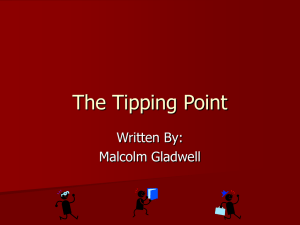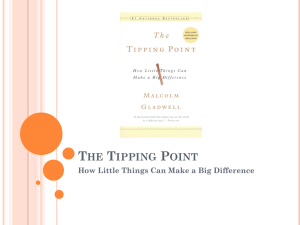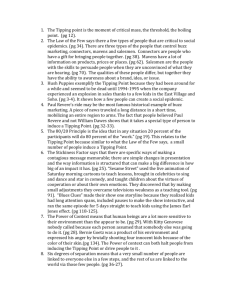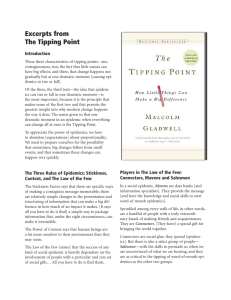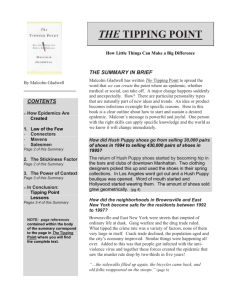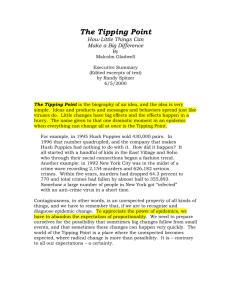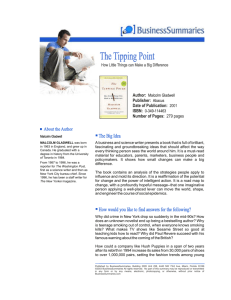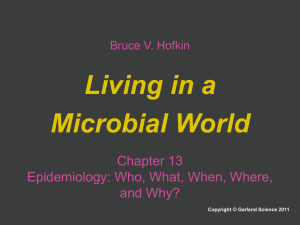The Tipping Point: Social Epidemics & Influence
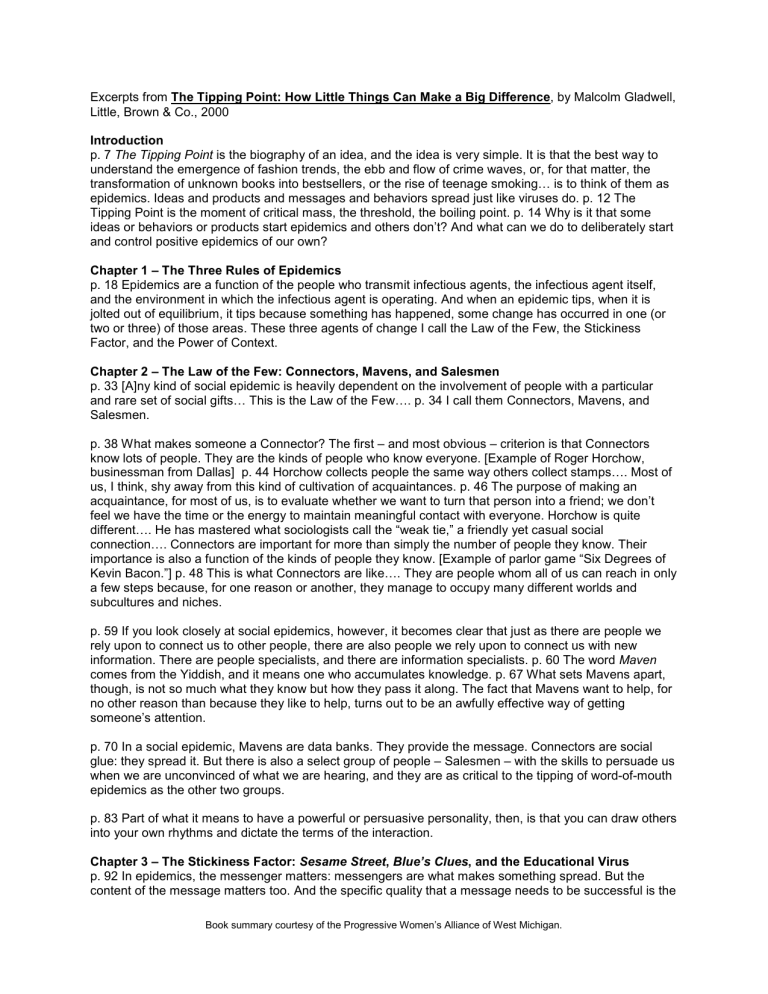
Excerpts from The Tipping Point: How Little Things Can Make a Big Difference , by Malcolm Gladwell,
Little, Brown & Co., 2000
Introduction p. 7 The Tipping Point is the biography of an idea, and the idea is very simple. It is that the best way to understand the emergence of fashion trends, the ebb and flow of crime waves, or, for that matter, the transformation of unknown books into bestsellers, or the rise of teenage smoking… is to think of them as epidemics. Ideas and products and messages and behaviors spread just like viruses do. p. 12 The
Tipping Point is the moment of critical mass, the threshold, the boiling point. p. 14 Why is it that some ideas or behaviors or products start epidemics and others don’t? And what can we do to deliberately start and control positive epidemics of our own?
Chapter 1 – The Three Rules of Epidemics p. 18 Epidemics are a function of the people who transmit infectious agents, the infectious agent itself, and the environment in which the infectious agent is operating. And when an epidemic tips, when it is jolted out of equilibrium, it tips because something has happened, some change has occurred in one (or two or three) of those areas. These three agents of change I call the Law of the Few, the Stickiness
Factor, and the Power of Context.
Chapter 2 – The Law of the Few: Connectors, Mavens, and Salesmen p. 33 [A]ny kind of social epidemic is heavily dependent on the involvement of people with a particular and rare set of social gifts… This is the Law of the Few…. p. 34 I call them Connectors, Mavens, and
Salesmen. p. 38 What makes someone a Connector? The first – and most obvious – criterion is that Connectors know lots of people. They are the kinds of people who know everyone. [Example of Roger Horchow, businessman from Dallas] p. 44 Horchow collects people the same way others collect stamps…. Most of us, I think, shy away from this kind of cultivation of acquaintances. p. 46 The purpose of making an acquaintance, for most of us, is to evaluate whether we want to turn that person into a friend; we don’t feel we have the time or the energy to maintain meaningful contact with everyone. Horchow is quite different…. He has mastered what sociologists call the “weak tie,” a friendly yet casual social connection…. Connectors are important for more than simply the number of people they know. Their importance is also a function of the kinds of people they know. [Example of parlor game “Six Degrees of
Kevin Bacon.”] p. 48 This is what Connectors are like…. They are people whom all of us can reach in only a few steps because, for one reason or another, they manage to occupy many different worlds and subcultures and niches. p. 59 If you look closely at social epidemics, however, it becomes clear that just as there are people we rely upon to connect us to other people, there are also people we rely upon to connect us with new information. There are people specialists, and there are information specialists. p. 60 The word Maven comes from the Yiddish, and it means one who accumulates knowledge. p. 67 What sets Mavens apart, though, is not so much what they know but how they pass it along. The fact that Mavens want to help, for no other reason than because they like to help, turns out to be an awfully effective way of getting someone’s attention. p. 70 In a social epidemic, Mavens are data banks. They provide the message. Connectors are social glue: they spread it. But there is also a select group of people – Salesmen – with the skills to persuade us when we are unconvinced of what we are hearing, and they are as critical to the tipping of word-of-mouth epidemics as the other two groups. p. 83 Part of what it means to have a powerful or persuasive personality, then, is that you can draw others into your own rhythms and dictate the terms of the interaction.
Chapter 3 – The Stickiness Factor: Sesame Street , Blue’s Clues , and the Educational Virus p. 92 In epidemics, the messenger matters: messengers are what makes something spread. But the content of the message matters too. And the specific quality that a message needs to be successful is the
Book summary courtesy of the Progressive Women’s Alliance of West Michigan.
quality of “stickiness.” Is the message – or the food, or the movie, or the product – memorable? Is it so memorable, in fact, that it can create change, that it can spur someone to action? p. 93 Reaching the consumer with the message is not the hard part of direct marketing. What is difficult is getting consumers to stop, read the advertisement, remember it, and then act on it. p. 95 If you look closely at epidemic ideas or messages, as often as not the elements that make them sticky turn out to be as small and seemingly trivial as Wunderman’s gold box [gimmick for Columbia Record Club ads]. p. 100 Sesame Street was built about a single, breakthrough insight: that if you can hold the attention of children, you can educate them. p. 110 This was the legacy of Sesame Street: If you paid careful attention to the structure and format of your material, you could dramatically enhance stickiness. But is it possible to make a show even stickier than Sesame Street ? [yes - story of Blue’s Clues ] p. 132 The Law of the Few says that there are exceptional people out there who are capable of starting epidemics. All you have to do is find them. The lesson of stickiness is the same. There is a simple way to package information that, under the right circumstances, can make it irresistible. All you have to do is find it.
Chapter 4 – The Power of Context (Part One): Bernie Goetz and the Rise and Fall of New York City
Crime p. 137 This was New York City in the 1980s, a city in the grip of one of the worst crime epidemics in its history. But then, suddenly and without warning, the epidemic tipped. From a high in 1990, the crime rate went into precipitous decline. Murders dropped by two-thirds. Felonies were cut in half. p. 141 Something else clearly played a role in reversing New York’s crime epidemic. The most intriguing candidate for that “something else” is called the Broken Windows theory. Broken Windows was the brainchild of the criminologists James Q. Wilson and George Kelling. Wilson and Kelling argued that crime is the inevitable result of disorder. If a window is broken and left unrepaired, people walking by will conclude that no one cares and no one is in charge. Soon, more windows will be broken, and the sense of anarchy will spread from the building to the street on which it faces, sending a signal that anything goes. In a city, relatively minor problems like graffiti, public disorder, and aggressive panhandling, they write, are all the equivalent of broken windows, invitations to more serious crimes…. This is an epidemic theory of crime. It says that crime is contagious – just as a fashion trend is contagious – that it can start with a broken window and spread to an entire community. [Benefits of transit authority’s focus on cleaning up graffiti, cracking down on fare-beating, NYPD crackdown on quality-of-life crimes] p. 146 Broken Windows theory and the Power of Context are one and the same. They are both based on the premise that an epidemic can be reversed, can be tipped, by tinkering with the smallest details of the immediate environment.
Chapter 5 – The Power of Context (Part Two): The Magic Number of One Hundred and Fifty p. 171 Once we’re part of a group, we’re all susceptible to peer pressure and social norms and any number of other kinds of influence that can play a critical role in sweeping us up in the beginnings of an epidemic.
Chapter 6 – Case Study: Rumors, Sneakers, and the Power of Translation p. 203 This is what is meant by translation. What Mavens and Connectors and Salesmen do to an idea in order to make it contagious is to alter it in such a way that extraneous details are dropped and others are exaggerated so that the message itself comes to acquire a deeper meaning. If anyone wants to start an epidemic, then – whether it is of shoes or behavior or a piece of software – he or she has to somehow employ Connectors, Mavens, and Salesmen in this very way: he or she has to find some person or some means to translate the message of the Innovators into something the rest of us can understand.
Chapter 7 – Case Study: Suicide, Smoking, and the Search for the Unsticky Cigarette p. 220 Teenage smoking is one of the great, baffling phenomena of modern life. p. 221 The anti-smoking movement has never been louder or more prominent. Yet all signs suggest that among the young the
Book summary courtesy of the Progressive Women’s Alliance of West Michigan.
anti-smoking message is backfiring…. The lesson here is not that we should give up trying to fight cigarettes. The point is simply that the way we have tended to think about the causes of smoking doesn’t make a lot of sense. What if smoking, instead of following the rational principles of the marketplace, follows the same kind of mysterious and complex social rules and rituals that govern teen suicide? If smoking really is an epidemic like Micronesian suicide, how does that change the way we ought to fight the problem? p. 227 Smoking, overwhelmingly, was associated with the same thing to nearly everyone [in a survey of earliest experiences with cigarettes]: sophistication. This was true even of people who now hate smoking, who now think of it as a dirty and dangerous habit. The language of smoking, like the language of suicide, seems incredibly consistent. p. 230 There is actually considerable support for this idea that there is a common personality to hard-core smokers…. p. 232 The significance of the smoking personality, I think, cannot be overstated. If you bundle all of these extroverts’ traits together – defiance, sexual precocity, honesty, impulsiveness, indifference to the opinion of others, sensation seeking – you come up with an almost perfect definition of the kind of person many adolescents are drawn to…. But they weren’t cool because they smoked. They smoked because they were cool…. [the smoking versions of Salesmen] This may seem like a simple point. But it is absolutely essential in understanding why the war on smoking has stumbled so badly. p. 238 If we are looking for Tipping Points in the war on smoking, then, we need to decide which of those sides of the epidemic we will have the most success attacking. Should we try to make smoking less contagious, to stop the Salesmen who spread the smoking virus? Or are we better off trying to make it less sticky, to look for ways to turn all smokers into chippers [someone who smokes no more than 5 cigarettes a day but smokes at least 4 days a week – the equivalent of a social drinker]? p. 251 What these figures tell us is that experimentation and actual hard-core use are two entirely separate things – that for a drug to be contagious does not automatically mean that it is also sticky….
What we should be doing instead of fighting experimentation is making sure that experimentation doesn’t have serious consequences. [e.g. better treatment of depression which is strongly linked to smoking, and development of products that keep nicotine below the common addiction threshold]
Chapter 8 – Conclusion: Focus, Test, and Believe
[Story of nurse’s campaign to increase awareness of diabetes and breast cancer in black community – had greater success when moved the campaign to beauty salons rather than seminars after church] p.
255 Starting epidemics requires concentrating resources on a few key areas. p. 257 The theory of Tipping Points requires, however, that we reframe the way we think about the world. p. 258 Those who are successful at creating social epidemics do not just do what they think is right. They deliberately test their intuitions…. To make sense of social epidemics, we must first understand that human communication has its own set of very unusual and counterintuitive rules. What must underlie successful epidemics, in the end, is a bedrock belief that change is possible, that people can radically transform their behavior or beliefs in the face of the right kind of impetus. p. 259 But if there is difficulty and volatility in the world of the Tipping Point, there is a large measure of hopefulness as well…. In the end, Tipping Points are a reaffirmation of the potential for change and the power of intelligent action.
Afterword: Tipping Point Lessons from the Real World p. 264 What is now obvious to me… is that we are about to enter the age of word of mouth, and that, paradoxically, all of the sophistication and wizardry and limitless access to information of the New
Economy is going to lead us to rely more and more on very primitive kinds of social contacts. Relying on the Connectors, Mavens and Salesmen in our life is the way we deal with the complexity of the modern world.
Book summary courtesy of the Progressive Women’s Alliance of West Michigan.
